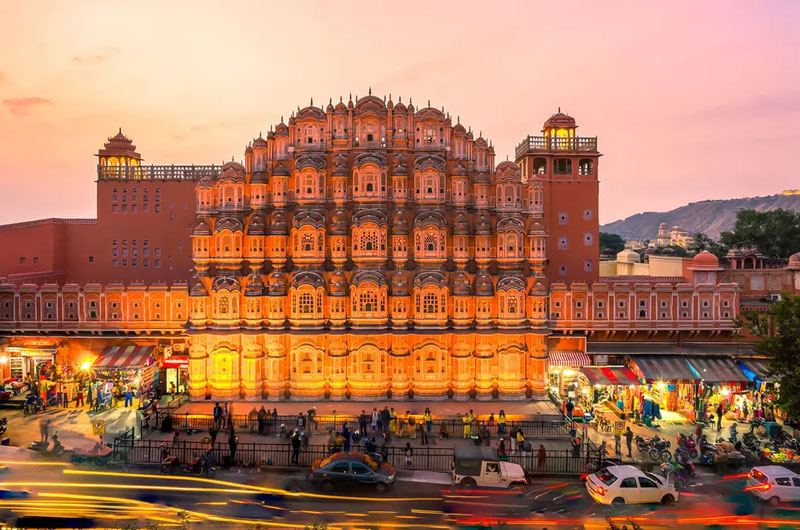
Jaipur City: A World Heritage Site
Jaipur, the capital city of Rajasthan in India, is renowned for its rich history, architectural brilliance, and vibrant culture. Recognized as a UNESCO World Heritage Site in 2019, Jaipur, also known as the “Pink City,” is a major tourist destination that offers a glimpse into the opulence and grandeur of the Rajput era. Its well-preserved palaces, forts, and temples attract visitors from all corners of the world, making it a jewel in India’s cultural crown.
Historical Background
- Foundation and Planning
- Founded in 1727 by Maharaja Sawai Jai Singh II.
- Designed by the chief architect Vidyadhar Bhattacharya, based on Vastu Shastra principles.
- Known for its grid-like layout, unique for its time.
- Architectural Influence
- Blend of Rajput, Mughal, and European architectural styles.
- Known for its pink-colored buildings, symbolizing hospitality.
Architectural Marvels
- City Palace
- Heart of Jaipur, a complex of palaces, courtyards, and museums.
- Houses the Chandra Mahal and Mubarak Mahal.
- Known for its intricate carvings and rich collections of artifacts.
- Hawa Mahal
- Also known as the “Palace of Winds.”
- Five-story structure with 953 small windows, or jharokhas.
- Designed for royal ladies to observe street festivals without being seen.
- Amber Fort
- Located on a hilltop, 11 kilometers from the city center.
- Blend of Hindu and Mughal architecture.
- Notable features include the Sheesh Mahal (Mirror Palace) and the Diwan-e-Aam (Hall of Public Audience).
- Jantar Mantar
- An astronomical observatory built by Maharaja Sawai Jai Singh II.
- Houses the world’s largest stone sundial.
- Reflects the scientific advancements of the period.
Specialty of Jaipur City
- Colorful Markets
- Johari Bazaar: Famous for its exquisite jewelry and gemstones.
- Bapu Bazaar: Known for textiles, handicrafts, and traditional Rajasthani attire.
- Tripolia Bazaar: Offers a variety of brassware and lac jewelry.
- Traditional Crafts
- Bandhani (tie and dye) textiles.
- Blue pottery, a unique art form of Jaipur.
- Kundan and Meenakari jewelry.
Tourism Aspects
- Visitor Experience
- Heritage walks and guided tours available.
- Sound and light shows at Amber Fort.
- Traditional Rajasthani cuisine at local eateries and luxury hotels.
- Festivals and Events
- Jaipur Literature Festival: A prestigious event attracting writers and literary enthusiasts.
- Teej Festival: Celebrated with great enthusiasm, showcasing local traditions.
- Gangaur Festival: A colorful celebration dedicated to Gauri, the goddess of abundance.
- Nearby Attractions
- Nahargarh Fort: Offers panoramic views of the city.
- Jaigarh Fort: Known for its extensive cannon foundry.
- Jal Mahal: A picturesque palace in the middle of Man Sagar Lake.
Impact on Locality
- Economic Significance
- Major contributor to the local economy through tourism.
- Provides employment to a significant portion of the population in tourism-related activities.
- Cultural Influence
- Preservation of traditional crafts and performing arts.
- Enhances community pride and identity.
Preservation and Challenges
- Conservation Efforts
- Ongoing restoration and maintenance by the Archaeological Survey of India.
- Local government initiatives to preserve the heritage and promote sustainable tourism.
- Environmental Concerns
- Impact of urbanization and modern development on heritage sites.
- Measures to control pollution and manage waste effectively.
Conclusion
Jaipur City, with its magnificent palaces, forts, and vibrant bazaars, offers an unparalleled journey into India’s royal past. As a UNESCO World Heritage Site, it stands as a testament to the architectural ingenuity and cultural richness of the Rajput era. The city’s unique charm and historical significance continue to attract tourists worldwide, making it a vital part of India’s cultural heritage. Efforts to preserve and protect Jaipur’s heritage ensure that this Pink City remains a beacon of historical and cultural splendor for future generations.
